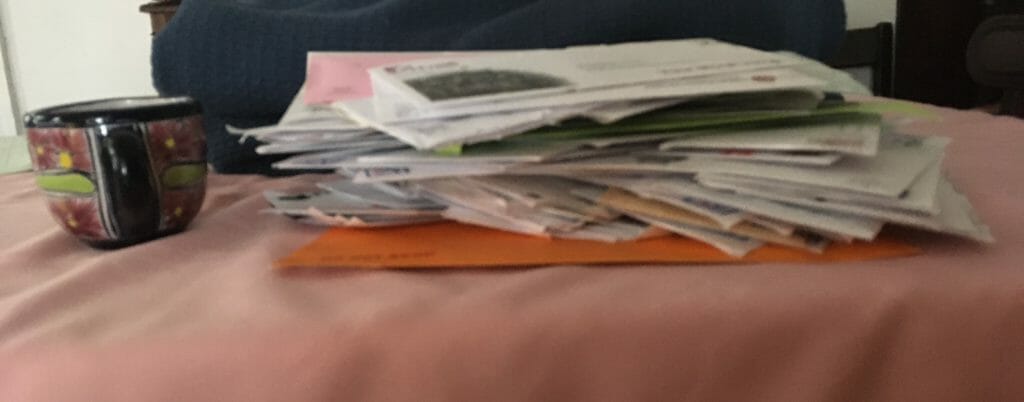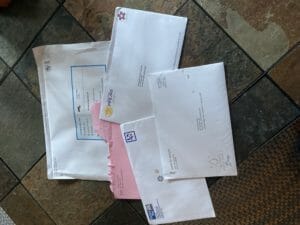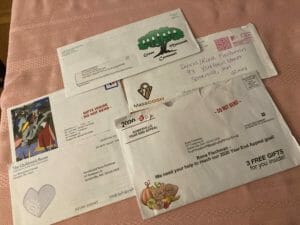A guest post by Grant Cobb of GivingMail
As you look forward to 2021 and beyond, consider new trends that begin to emerge and the long-standing efforts that persevere when crafting your fundraising campaigns. One of our favorites that continues to stand the test of time is direct mail.
Our GivingMail guide on direct mail for nonprofits shares that direct mail continues to be the leading source of individual donations in the U.S. So, yes, direct mail should be a part of your fundraising campaign.
Through our 70+ years of experience, we know a thing or two about hosting a successful direct mail fundraising campaign—and we’ve put together this quick guide so that you can too. Specifically, we’ll discuss the following key points:
- Integrating direct mail and digital strategies
- Building relationships with supporters
- Thanking donors for their contributions
- Direct mail best practices
Integrating direct mail and digital strategies
Direct mail is an important channel for grabbing your audience’s attention and encouraging them to give. But is it enough?
According to 360MatchPro’s fundraising statistics list, 16% of donors prefer to give via direct mail. That’s a good portion of your audience that will be happy to mail a check for your fundraising campaign. However, there’s still a large number of supporters who might prefer to give digitally. The solution? Integrating your direct mail and virtual fundraising strategies.
Here are three simple ways to do so:
- Include an easy-to-type URL in your direct mailing.
- Generate and display a QR code leading to your donation page.
- Incorporate your text-to-give number and keyword.
Integrating your direct mail and digital strategies allows you and your supporters to get the best of both worlds. You can grab your audiences’ attention with one of the most powerful marketing and communication channels available while still allowing them to give in the most convenient way.
Building relationships with supporters
Even beyond the actual donation ask, direct mailings can greatly impact your donor relationships and how recipients view their connection to your organization.
Essentially, sending campaign updates, informational newsletters, and other types of non-fundraising asks via direct mail can be a fantastic way to communicate to donors that they matter on a level that’s deeper than their wallets. This is referred to as donor stewardship or cultivation efforts, and it’s a critical component of bringing supporters into the mix as partners.
Direct mail is also one of the most powerful communication channels for this type of relationship-building due to its ability to break through the digital clutter. Studies show that written words can keep your organization at the top of the recipient’s mind for longer than if they were to read about your work on a screen.
Thanking donors for their contributions
Even once you’ve received your donation, it doesn’t mean your job as a fundraising professional is over. Instead, it’s time to continue deepening your relationships with donors—starting with a specific, detailed thank-you.
So how should you communicate your appreciation to your supporters? There’s a bit of controversy in the fundraising space about whether an email can suffice as a thank-you message or whether a direct mailing should be required. In our opinion, a thank-you email can be an excellent first step, but it definitely shouldn’t be the last. Instead, a physical thank-you note sent to a donor’s mailbox can make a significant impact on their connection to your organization.
Luckily, free templates like these can help you craft your messages with ease. Simply start with a sample thank-you letter, and be sure to add important details like addressing the recipient by their preferred name and acknowledging their specific gift. Let’s compare these two potential messages:
- Dear Donor, thank you for your generous gift to our organization.
- Dear Brenda, thank you for your gift of $100 to help provide impoverished students in our community with the school supplies they need to succeed.
The first example seems like it was mass-sent to anyone who had donated recently. The latter is a specific message crafted carefully with the intended recipient in mind. The added effort that goes into sending a thank-you letter via direct mail rather than email can also show your increased dedication to appreciating donors effectively.
Direct mail best practices
Now that you understand the purpose of direct mail in fundraising, it’s essential to get your message out in the most effective way possible. Let’s discuss a few key strategies and tips:
1. Include specific donation requests
In any direct mail appeals you send, it’s important to include a specific call to action. In a typical fundraising letter, the intended action is to complete a donation.
However, making a broad request for donations can be too vague to drive results. That’s why you should be sure to include specific numbers to help guide the donor on their giving path.
Take a look at these examples:
- A donation of $25 can feed a hungry child for one week.
- A donation of $100 can feed a hungry child for one month.
- A donation of $500 can feed a family of four for one month.
All of these requests are more effective and actionable than “Please donate to our organization.”
By incorporating specific dollar amounts, along with the tangible impacts of each donation size, you encourage recipients to support your organization and its mission by giving more. Plus, you can leverage the power of social proof by showing potential donors what a typical gift size is, which removes the uncertainty around what they’re “supposed to” give.
2. Invest in high-quality materials
Even the most well-written fundraising letter won’t ensure results (or donations) if you neglect the appeal’s physical aspects. If it comes across as looking unenticing or otherwise spammy, it might even go straight from the mailbox to the trash can! One way to avoid this phenomenon is by investing in high-quality materials (like paper, ink, and envelopes) for your mailings.
- Print your direct mailings on high-grade paper (at least 60#).
- Use a decent printer and ink so that your text/imagery is legible and visually appealing.
- Include a pre-paid, pre-addressed return envelope with any direct mail appeals.
Putting thought into optimizing your direct mailings’ physical elements is a great way to increase your envelope open rate. At this point, your content’s quality will take over in coaxing a donation from the reader. After all, making a good first impression matters.
3. Outsource your direct mail efforts
A well-planned-out direct mail fundraising campaign could take a lot of work to pull off. However, it’s possible to outsource the bulk of the effort to a dedicated direct mail fundraising company and save time and money for your mission.
Just like working with an experienced fundraising consultant can help your team make the most of your efforts (and your fundraising dollars), a direct mail platform can help you send your appeals effectively while seeing the most outstanding results.
Not only can this type of partner provide you with free and effective donation request letters and templates, but they can also assist you in sending your letters in the most time- and cost-efficient manner possible.
Direct mail companies can even help send your mailings for less than it would cost to purchase paper, ink, envelopes, and stamps on your own—thanks to bulk discounts made available by bundling your appeals with other organizations.’ It’s a win-win!
Just remember—it’s not good enough to scribble a note and drop it off at the post office. Make sure to craft your appeals carefully to increase the likelihood of your letter being opened, read, and responded to. Good luck!
Grant Cobb is a fundraising specialist with over 6 years of experience in the nonprofit space. Currently the head of marketing and analytics at GivingMail, he is a huge proponent of data-driven decision making and the push to bring high-level analytics and fundraising to all.







